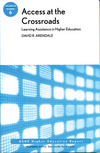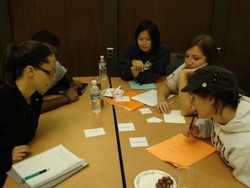
This blog focuses on my scholarship in my five research projects: learning assistance and equity programs, student peer study group programs, learning technologies, Universal Design for Learning, and history simulations. And occasional observations about life.
Lilly, M., & Sands, J. (2019). Guide for Peer Learning Facilitators. University of Minnesota https://z.umn.edu/PALfacilitatorguide
The Guide for Peer Learning Facilitators is the foundation of a formal training program at the University of Minnesota, in which undergraduate students learn how to lead weekly study sessions for their peers in a classroom setting for specific courses – primarily ones with high enrollment and prone to higher than average D,F, Withdrawal rates. Training and professional development throughout the academic year have been the cornerstones to the success the facilitators have realized. The eight principles that govern the program – crafted by Dr. David Arendale in his original publication of the same name – address topics such as cooperative learning theory, multicultural competency, metacognition, study strategies, and group dynamics. The book, updated in April 2019, also provides a directory of useable forms and worksheets and a bibliography of related publications.
Universal Design for Learning Explained by Kirk and Spock
History Simulations: Engaging Critical Thinking and Developing Multiple Perspectives from Other Cultures

Approaches to Learning Assistance: Concurrent Acquition of Knowledge and Skills
 With this blog posting, I pick back up on my series of samples from my book, Assistance at the Crossroads described in the left-hand column of this website. There are many ways that academic help can be provided for college students who are struggling in some of their classes.
With this blog posting, I pick back up on my series of samples from my book, Assistance at the Crossroads described in the left-hand column of this website. There are many ways that academic help can be provided for college students who are struggling in some of their classes.
This learning assistance approach operates through concurrent learning experiences. Students simultaneously enroll in a college-level class, whether or not they have been identified as academically underprepared, and use learning assistance services to support their learning in that class. A common characteristic of such a class is academic rigor exceeding the average of other college-level classes. These courses are challenging for many students, and the classes have high withdrawal and failure rates. Sometimes they are called “gatekeeper” classes (Jenkins, Jaggars, and Roksa, 2009).
For purposes of this discussion, this historically difficult class is called a “target class,” as learning assistance services are customized and “targeted” for serving students enrolled in that specific course. Other students in the same class that have not been identified as academically underprepared for content material in that particular class are welcome to use the learning assistance activities as supplemental or enrichment experiences to deepen mastery of course content. This concurrent acquisition approach is divided into three smaller groups of activities: those offered as supplemental learning experiences through the student’s voluntary participation; those offered as a coordinated program that requires moderate involvement by the target course instructor; and those embedded, infused, or mainstreamed in the course targeted for academic support that thereby serve all students enrolled in the class, regardless of their academic preparation.
One of the activities described in the previous section on prerequisite acquisition approaches could also have appeared in this section. Because most students enroll in only a single developmental course, the rest of their courses are at the college level. These students concurrently develop competency through the developmental course while they advance their knowledge and skills through the college-level courses. The key issue that places developmental courses in the previous section is that students are not ready to enroll in the college-level course for which they are underprepared. They are, however, ready for enrollment in other college-level courses. (To be continued.....)
2017 Directory of Apple TV Apps

This document provides an overview of the Apple TV apps I have found useful as a college educator and in my personal life. I enjoy Apple TV since I am able to watch on a large-screen with a great sound system the same content that used to be confined to my iPhone, laptop, or desktop computer. There is enough free content available through Apple TV that I could cancel my cable TV subscription. I will be interested to see the bundle of cable channels that will be eventually available for a monthly charge from Apple.
At the University of Minnesota where I am a history professor, the Apple TV device has been integrated into a growing number of classrooms so that students can share video content through the room projection television system. First-year students in the College of Education and Human Development receive an iPad upon arrival and use of it is integrated into many of their first-year courses. I use the history apps to help me connect today’s events with the history topics we are studying in class.
Expanded 2016 Directory of Apple iPad apps for classroom and personal life
This document provides an overview of the iPads apps I have found useful as an educator and in my personal life. Most of the apps were free, some cost a dollar or two. I have a separate section in the directory for the apps used in my college history course as well as current history events that are also integrated into class sessions.
Some of the Apple iPhone and Apple TV apps on those iOS devices will download to your iPad. This automatic downloading only occurs if the iOS devices have the automatic downloading enabled through the settings of the iOS device. I have noticed that some Apple TV apps will download to the iPad but not to the iPhone. This may have to do with whether they can display on the smaller iPhone screen than the larger iPad.
Features of the Apple iPad
There are four features of the Apple iPad I find compelling in comparison with other desktop or laptop computers:
- Due to its slim design and modest weight, mobility is a key feature. I carry around the home and use in different places. Rather than feeling burdened by its constant connection to the Internet through WI-FI, I use it frequently as a resource to enhance other parts of my life.
- For me, the touch screen with the iPad is an enjoyable way to interact with the device. This tactile interaction with the iPad is different from use of a traditional keyboard and a mouse.
- Ease and enjoyment of reading has been increased since I can use the touch screen easily with my fingers to enlarge the image or text to increase readability and focus attention. While the pinch and zoom feature is not available through all apps, nearly all of them allow easy increase or decrease of text size as well as changing the font and the background color of the publication.
- The apps. With the total approaching two million to select from, there is an app for nearly everything. While creating an app requires great skill, it has opened opportunities for many more software designers to share their applications for free or very modest cost. The app store through Apple provides a very democratic way for people to widely share their work with others.
Check the App Store Often
This abridged directory contains apps that are often free and are of my interest and taste. With additional ones being added weekly, this directory does not try to be inclusive of all of them. You can go to the official Apple App store and use the options on the top menu bar to search all apps by name, category, and whether paid or free I also downloaded some apps noted below that focus on identifying the newest and best apps. I have noticed that some apps are free for the first week or two they are introduced and then they become paid only. I think this is done to generate positive buzz and reviews in the App Store to encourage future consumers to purchase them. I have made it a game to check out the official App Store every few days.
2016 Annotated Bibliograpy of Postsecondary Peer Cooperative Learning Programs Updated

This annotated bibliography does not attempt to be inclusive of this broad field of literature concerning peer collaborative learning. Instead, it is focused intentionally on a subset of the educational practice that shares a common focus with increasing student academic achievement and persistence towards graduation.
The seven student peer learning programs included in this bibliography meet the following characteristics: (a) the program must have been implemented at the postsecondary or tertiary level; (b) the program has a clear set of systematic procedures for its implementation that could be replicated by another institution; (c) program evaluation studies have been conducted and are available for review; (d) the program intentionally embeds learning strategy practice along with review of the academic content material; (e) the program outcomes include increased content knowledge, higher final course grades, higher pass rates, and higher college persistence rates; and (f) the program has been replicated at another institution with similar positive student outcomes. From a review of the professional literature, six programs emerged: (a) Accelerated Learning Groups (ALGs), (b) Emerging Scholars Program (ESP), (c) Peer Assisted Learning (PAL), (d) Peer-Led Team Learning (PLTL), (e) Structured Learning Assistance (SLA), (f) Supplemental Instruction (SI), and (g) Video-based Supplemental Instruction (VSI). As will be described in the following narrative, some of the programs share common history and seek to improve upon previous practices.Other programs were developed independently.
Regrets for scholarship I have overlooked. Please send me items you think should be included in the next edition. Happy reading.


